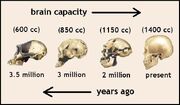
Evolution Of The Brain
Excerpt from a documentary about the evolution of the brain showing all the stages from the first neurons to the current human brain.

The above graphic depicts a steady and rapid increase in human brain size starting from approximately 5 million years ago through 200,000 years ago
Although brains were certainly not a new or novel feature exclusive to humans, the emergence of early humans some 5 million years ago marked the development of a brain with some very unique characteristics.
Evolution of the Human Brain[]
The early human brain cortex was larger than other mammals, and was organized into thousands of tiny neutron-containing columns (Evolution of the Brain, n.d.). Connected by an intricate set of nerve cell circuits, these columns not only processed and filtered of information, but also allowed for more unique and complex functions such as memory storage, learning, and planning (Evolution of the Brain, n.d.). The ancestral human brain continued to rapidly evolve, steadily growing larger and more complex. For instance, within 3 million years, the early hominid brain increased by about half of a pound, which corresponded with the emergence of tool making; over the next million years, the brain increased by another half pound, and corresponded with even more complex activities such as the controlled use of fire (Evolution of the Brain, n.d). The human brain of today, which is basically the same brain of the first Homo sapiens 100,000 years ago, is now four times larger and 3 times heavier than the early human brain of 5 million years ago (Evolution of the Brain, n.d.; Mann, 2007).
Although the large and complex human brain has allowed many great benefits including complex use of language and high level of cognition, it also has some distinct disadvantages. As highlighted in the opening line of this NPR broadcast: http://www.npr.org/templates/story/story.php?storyId=129027124, “From one perspective, the human brain is a masterpiece. From another, it's 3 pounds of inefficient jelly.” This broadcast goes on to highlight some of the less advantageous features of the human brain such as slow processing time and high energy demands.
References[]
Evolution of the Brain [video clip] (n.d.) . Retrieved from: http://www.youtube.com/watch?v=u85MxtyEl68
Hamilton, J. (2010, August 9). From Primitive Parts, A Highly Evolved Human Brain [radio broadcast]. National Public Radio. Retrieved from: http://www.npr.org/templates/story/story.php?storyId=129027124
Mann, N. N. (2007). Meat in the human diet: An anthropological perspective. Nutrition and Dietetics, 64(S4), S102-S107. doi:10.1111/j.1747-0080.2007.00194.x